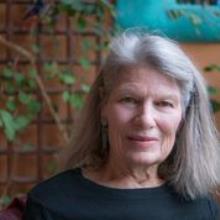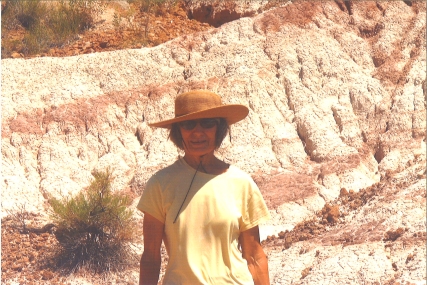|
Shelley Armitage grew up in the small ranching and farming community of Vega, Texas, in Oldham County in the northwest Texas Panhandle. She still owns and operates a family farm inherited from her parents.
Though most of her adult life has been spent away from the Panhandle as a university professor in Texas, New Mexico, and Hawai’i, Armitage has always returned to the “farm,”—particularly in the summers– which offered until recently a 360 degree view of earth and sky. Observing the natural world and its changes remains for her a centering and care-giving activity, following her father’s legacy. Growing up in small town Texas where one can be a basketball star or drum major one night and in the local beauty and talent contest the next, Armitage had the opportunity to try her hand at many things. Running a farm was not expected to be one of them until both parents and her brother passed. Today the landscape surrounding Armitage Farms appears overwhelmed by the massive wind turbines, soaring microwave towers, constant oil pumping rigs, and persistent sand and gravel digs. Restoration and conservation of land for Armitage is both an ecological and aesthetic necessity. She decided to convert the farmland—originally requiring herbicides, fertilizer, and disruptive practices– into conservation grass planted to restore fragmented landscapes by recreating wildlife corridors and habitat. Armitage’s professional life has offered her a more philosophical connection with landscape through studies of photography, environmental literature, cultural and place studies. Choosing to live and work in diverse places—Fulbright Grants in Portugal, Poland, Finland, and Hungary, teaching In the Southwest and Hawai’i, researching in New York, Washington DC, Oregon, Illinois, Missouri, Connecticut—place has taken on special meanings and promoted fresh curiosities. As author of eight books and fifty articles and essays, she has held Fulbright Chairs in Warsaw and Budapest, a Distinguished Senior Professorship in Cincinnati, and the Dorrance Roderick Professorship in El Paso as well as three National Endowment for the Humanities grants, a National Endowment for the Arts grant, and a Rockefeller grant. “Writing llano,” as she calls the intimately physical and intellectual sensitivity to place, is a restorative act where memories and stories may reconnect people and places through time. Even as the heartland remains in the Panhandle, the compass foot reaches out. She resides part of each year in Las Cruces, New Mexico. |

 Her dad purchased the 1200 acres of native grass, wheat and milo farmland bordering Highway Interstate 40 on the south and the Canadian River breaks on the north in l929, a landscape Armitage shared from childhood on, riding with her father and grandfather to check crops and cattle and later jogging and today walking the farm roads.
Her dad purchased the 1200 acres of native grass, wheat and milo farmland bordering Highway Interstate 40 on the south and the Canadian River breaks on the north in l929, a landscape Armitage shared from childhood on, riding with her father and grandfather to check crops and cattle and later jogging and today walking the farm roads.